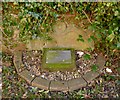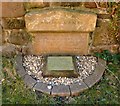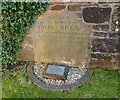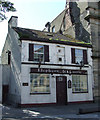For context, see
Image, where the stone can be seen in the left foreground, built into the southern boundary wall of the kirkyard.
"Sacred to the memory of John Bell, flesher in Dumbarton, who died on the 19th day of October 1825 in the 55th year of his age."
The date of death given in this inscription is incorrect, as will be explained below. For reasons that will also become clear below, I will refer to the John Bell of this gravestone as John Bell (II).
John Bell (II) was from Brampton, Cumberland (c.
Image), and was born on the 23rd November 1770. Donald MacLeod gives his obituary on page 232 of his book "The God's Acres of Dumbarton" (1888). MacLeod has the family being from "Bampton", and, confusingly, there is a Little Bampton and a nearby Kirkbampton in Cumberland, but the family was not from that area.
The ancestry of the family can be traced back a little further, to John's grandfather Richard Bell, who was a flesher in Brampton, Carlisle. On pages 59-61 of "Ancient Records of Dumbarton and Glasgow", we are presented with the text of a document recording that Richard's son John (I) had bound himself apprentice to his father (this took place in Brampton, before the family had come to Dumbarton). The document dates from 1748, and reads, in part, as follows:
"This Indenture made the first day of May in the twenty first year of the Reign of our Sovereign Lord George the second, ... and in the year of our Lord one thousand seven hundred and forty eight Witnesseth that John Bell, son of Richard Bell of Brampton, in the parish of Brampton in the county of Cumberland, hath of his own free and voluntary will placed and bound himself apprentice unto the said Richard Bell his father, Butcher, to learn the said Trade, Mistery or occupation of a Butcher, which he the said Richard Bell now useth, and with him as an Apprentice, to dwell continually with him from the day of the date hereof to the full term of seven years from thence, next insuing and fully to be compleat and ended."
The John Bell (I) named here is presumably the father of the one named on the gravestone, who I have therefore called John (II). Note that John Bell (II) had not yet been born when this Indenture was recorded in 1748. The book "Ancient Records ..." goes on to explain that "the John Bell of the above indenture was grandfather of Messrs John Bell and George Bell, Dumbarton, and Finlay Bell, Glasgow".
The last-named John Bell (III) is most likely John Bell of Clydeview (d.1899), eldest son of John (II). For more on him, see below.
As for John (I), who was apprenticed to his father Richard, the book "Ancient Records ..." also presents, on pages 61-62, the text of his burgess ticket: it was made "at Dumbarton the twentieth day of April seventeen hundred and seventy nine years", and it records that "Mr John Bell Flesher in Carlile ... was admitted and received an Burgess and Guild Brother of Dumbarton with power to him to hold and enjoy all the priviledges and Immunities thereto belonging".
- - • - -
Coming now to the John (II) of the gravestone, his obituary is, as noted above, given by Donald MacLeod on page 232 of his book "The God's Acres of Dumbarton" (1888); it can be summarised as follows:
John was born on November 23rd 1770. When he was still young, John and his brother William were brought by their father [not named by MacLeod, but presumably John (I)] to Dumbarton, where John (II) was trained to become a flesher by trade. He became a burgess of the town in 1787, and he married one of the Langs of Chapelton (compare
Image). Five sons (John, William, George, Thomas, Finlay) and one daughter (Margaret Lang) survived their father. At the time the book was written (1888), only the eldest son John (III) and youngest son Finlay were still alive.
On the morning of Friday the 21st of October, 1825, the John Bell (II) who is commemorated by this gravestone was, in connection with his work, returning from a cattle fair at Kilmichael (c.
Image), Lochgilphead. Unfortunately, he was returning on the ill-fated steamer "Comet II"; later on the same morning, it would be involved in a collision with the steamship "Ayr". John was among the many who drowned as a result; his body was recovered on the following day. The date of death that appears on the stone is incorrect.
[The PS Comet and the PS Comet II were both built by Henry Bell:
Image The first Comet was built in 1811, and was shipwrecked in 1820. The Comet II was built in 1822, and sank, as mentioned above, in 1825.]
The family's trade as fleshers (butchers) in Dumbarton is also mentioned in passing by Donald MacLeod in another of his works, "Dumbarton Ancient and Modern" (1893). The relevant passage is in section VI, "Old Flesh Market and Town's Well", which faces an illustration of the old flesh market; that section begins:
"The Flesh Market was the last of the public markets of the burgh to be discontinued. It was built in 1670, and pulled down in 1852. Mr William Taylor's public house of entertainment now stands on its site. The Slaughter-house of the burgh was in the back part of the premises, and the town's well was in front of them, and it was supplied by water from St Shear's Well, on the opposite side of the Leven, by a lead pipe laid in 1714 on its bed, the whole works costing £54 sterling. Many a flutter have I seen among the attendant maidens when infuriated cattle were being driven past them by half fu' drovers to meet their doom. There were for many long years six or eight fleshers who occupied stalls in the market, but they dwindled down by slow degrees till in my early days there was only one, and that one was Mr William Bell, father of our esteemed townsman, ex-Bailie George Bell, and uncle to our much revered oldest inhabitant, Mr John Bell of Clydeview, late flesher, whose father (a native of Brampton, Cumberland) came to reside in the burgh about 110 years ago, and he at one time also occupied a stall in the market, and met his death by drowning when the second steamship 'Comet' was run down by the steamer 'Ayr' off Kempoch Point, Gourock, on the morning of Friday, 21st October, 1825, when seventy lives were sacrificed."
My comments on that passage:
● For St Shear's Well and the water pipe from there, see
Image
● "Our much revered oldest inhabitant, Mr John Bell of Clydeview": presumably John (III), eldest son of John (II); he was therefore alive, though very elderly, in 1893. In fact, he went on to live several years longer (7th June 1803 - 2nd May 1899. The following biographical details of John Bell are taken mainly from his obituary in the 6th May 1899 edition of the Lennox Herald newspaper.
John Bell (III) stayed in the house called Clydeview until 1897, the year his wife died; at that time, he sold Clydeview to Mr Leslie Denny, a Dumbarton shipbuilder, and moved to the British Linen Bank House, Alexandria, where he stayed with Thomas McLean, whose wife was a niece of Mr Bell. John Bell was a flesher by trade, retiring in 1866. He had been a town councillor, long associated with the management of the parochial boards of Dumbarton and Cardross, and with the Dumbarton Combination Poorhouse, before these passed into the control of the parish councils.
John Bell was a very early shareholder of the Loch Lomond Steamboat Company, and had been one of its directors for many years, until the steamers were purchased in 1889 by the North British Company. As a youth, John had been present at the launch of the steamer "Marion", built for Loch Lomond by William Denny, Dumbarton. He also remembered well the arrival in Dumbarton of news about the Battle of Waterloo, and the excitement it caused there.
In 1822, John Bell joined the Dumbartonshire Yeomanry Cavalry, whose captain was Alexander Smollett of Bonhill (see
Image). In 1822, he visited Edinburgh, to see the King George IV, who was visiting the city. In John's early years, travel was mainly by stagecoach, but he saw the progress of the railways; in 1832, he travelled on the Manchester & Liverpool line the day after it opened. He had a vivid recollection of the Chartist Riots at the time of passing of the Reform Bill, and was present when three Chartists were on trial in Dumbarton Parish Church (
Image).
John Bell (III) became a Freemason early in 1826; at the time of his death in 1899, his record of 73 years made him the oldest Freemason in Scotland. He belonged to Lodge No 18, St John Kilwinning, Dumbarton. He attended many masonic functions, being present, for example, at the laying of the foundation stone of the first Hutchesontown stone bridge in Glasgow, in 1826. His first wife was a daughter of Mr James Watson of Glenfalloch, Loch Lomond. John Bell attributed his long life to "early rising, temperate in everything, avoiding medicine if possible, and taking a cold bath every morning".
Some details not given in that obituary: his first wife was called Elizabeth Watson; she was born in 1812, and died in 1847. His second wife was Louisa Hamilton; she was born in 1826, and died in 1897.
● "Mr William Bell, father of our esteemed townsman, ex-Bailie George Bell": this William is the brother of John (II); William is mentioned by name in the "God's Acres" obituary, summarised above, as being brought with John (II) to Dumbarton by their father.
By the time John (II) met his death by drowning, he had already given up his stall in the old Flesh Market, and for a good many years had instead been conducting his business from a shop. His brother William, the last to have had a stall in the Flesh Market, went about his work quietly, minding his own business; he therefore attracted little comment, but he is known to have enlisted in the local yeomanry, and to have done duty at Stirling [for the references in this paragraph, see Donald MacLeod's book "Past Worthies of the Lennox" (1894)].
Ex-Bailie George Bell (son of William) was a good friend of Donald MacLeod, the author of most of the reference works that I have relied on in this item. They were both members of the Dumbarton lodge of the Oddfellows: note the mention of George Bell on
Image in Dumbarton Cemetery. George Bell's own gravestone is located in the same cemetery, and is about midway between
Image and the statue of John Proudfoot (
Image). The gravestone of John Bell (III) is just a few feet from the White Memorial.
For John Bell (III), ex-Bailie George Bell, and their relatives, see
Image, which shows some of the stones just mentioned.
- - • - -
It may be useful to summarise the successive generations:
(1) Richard Bell, flesher in Brampton, Carlisle.
(2) John (I), apprenticed to his father in 1748, and made a burgess of Dumbarton in 1779.
(3) John (II) of this gravestone, and William his brother, brought to Dumbarton by their father in the late 1770s or early 1780s ("about 110 years ago" according to the 1893 book "Dumbarton Ancient and Modern"); presumably in 1779 or just before, since John (I) was made a burgess of Dumbarton in that year. John (II) became a burgess of Dumbarton in 1787.
(4) John (III) of Clydeview (d.1899), son of John (II); his cousin, Bailie George Bell, was the son of the above William.
For some of those later generations, see
Image, in Dumbarton Cemetery.
If the dates listed in "God's Acres" are correct, John (II), said to have been born in November 1770, was just 16 years old when he was made a burgess of Dumbarton in 1787. Providing some corroboration for the dates when various members of that family were made burgesses are the following entries from the published "Roll of Dumbarton Burgesses and Guild-Brethren 1600-1846 with a continuation thereof to the present day" (Edinburgh, 1937; compiled by Fergus Roberts, Town Clerk of Dumbarton):
• Bell, John, flesher in Carlisle, B. and G., gratis, by act of C. – 20 Apr 1779.
• Bell, John, junior, butcher, B. and G. – 8 May 1787.
• Bell, John, junior, flesher, B. and G., by r. of being s. to a B. – 19 May 1824.
• Bell, William, butcher, B. and G. – 7 Aug 1807.
"B." = burgess of Dumbarton. "G." = guild-brother. "By act of C" = by act of Council. "By r. of being s. to a B." = by right of being son to a burgess of Dumbarton.
"Gratis": created an honorary burgess. As the work just cited points out, large numbers of honorary burgesses were created from 1767–87 because it provided revenue for the Common Good and for the Town Clerk, and because it "made possible a carousal for the members of the Council"; in other words, it provided an excuse for the Council to have a drinking party.











